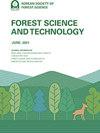Impact of thinning and pruning on tree growth, stress wave velocity, and pilodyn penetration response of clonal teak (Tectona grandis) plantation
IF 2.2
Q2 FORESTRY
引用次数: 9
Abstract
Abstract The objective of this research was to examine the impact of different thinning and pruning intensities on the growth characteristics and wood properties of clonal teak. A 14-year-old clonal teak plantation was used in the study. The first thinning and pruning were established 5 years after planting. Three different levels of thinning (un-thinned, moderate, and heavy) and pruning (low, medium, high) were tested. Growth characteristics, pilodyn penetration, and stress wave velocity were examined. Results showed that different thinning intensities significantly affected the mean annual diameter increment (F = 37.67; p < 0.01). The standing stock estimations of the thinning intensity regimes also significantly differed between different thinning intensities (F = 4.16; p = 0.035). Moreover, pilodyn penetration significantly varied with the thinning treatment (F = 23.53; p < 0.01). The stress wave velocity, however, did not significantly vary with the thinning treatment (F = 2.54; p = 0.11). Meanwhile, the effect of pruning treatment was not observed under all parameters. Heavy thinning treatment promoted all parameters except height and stress wave velocity. A strong positive correlation was observed between pilodyn penetration and DBH. This result suggested that thinning and pruning promoted positive DBH growth and an increase in the economic value of the stand, but it did not affect the wood properties of clonal teak wood.间伐和修剪对克隆柚木人工林树木生长、应力波速度和渗透响应的影响
摘要本研究旨在探讨不同间伐和修剪强度对克隆柚木生长特性和木材性能的影响。以14年无性系柚木人工林为研究对象。第一次间伐和修剪是在种植5年后建立的。测试了三种不同程度的间伐(未间伐、中度间伐和重度间伐)和修剪(低、中、高)。检测了生长特性、导绳穿透度和应力波速。结果表明:不同间伐强度对林分年平均径增量有显著影响(F = 37.67;p < 0.01)。不同间伐强度下的林分蓄积量估计值也存在显著差异(F = 4.16;p = 0.035)。此外,随着疏化处理的不同,潜射量也有显著变化(F = 23.53;p < 0.01)。应力波速度随减薄处理变化不显著(F = 2.54;p = 0.11)。同时,在所有参数下均未观察到修剪处理的效果。除高度和应力波速外,重疏处理对其他参数均有促进作用。领航胶穿透度与胸径呈正相关。结果表明,间伐和修剪促进了林分胸径的正增长,提高了林分的经济价值,但对无性系柚木的木材性能没有影响。
本文章由计算机程序翻译,如有差异,请以英文原文为准。
求助全文
约1分钟内获得全文
求助全文

 求助内容:
求助内容: 应助结果提醒方式:
应助结果提醒方式:


